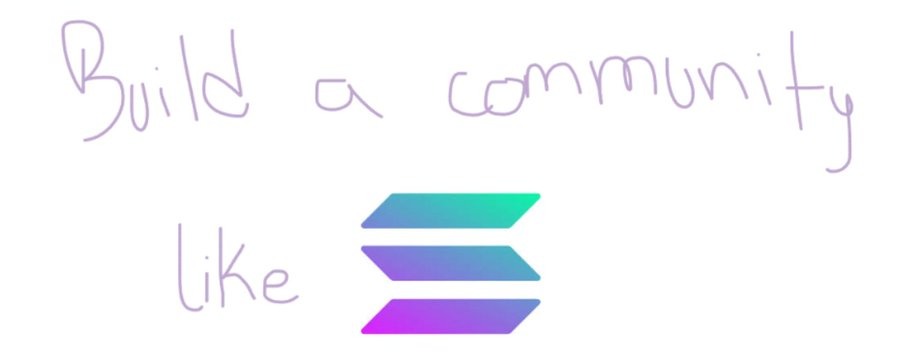How Solana Built a Cult-Like Web3 Community (And What You Can Learn From It)

Solana has one of the best example of what a healthy, active, and loyal Web3 community looks like. But this wasn’t created overnight. Solana’s explosive community-driven growth has been fueled by a deliberate, structured community and marketing strategy that leans heavily on cultural alignment, constant engagement, and grassroots community empowerment.
In this post, we’ll break down the foundational components of Solana’s community marketing playbook, the tactics behind its global ecosystem, and how your Web3 project can borrow the same techniques to build a thriving, self-sustaining community.
Why Community-Led Marketing Works in Web3
In Web3, community is more than a marketing channel. It’s a core part of the product. A well-aligned, constantly activated, and interconnected community can become your most effective and sustainable distribution engine.
The goal for any Web3 project should be to build a self-sustaining, community-powered flywheel where users become contributors, contributors become evangelists, and evangelists become the engine of growth.
Solana has done this exceptionally well. Their strategy rests on three key pillars:
- Community alignment
- Constant activation
- Many-to-many relationships
Let’s explore each in more detail.
Community Alignment: Cultural and Economic
Most Web3 communities achieve economic alignment via tokens and product usage. Token holders are financially incentivized to promote the project because their success is directly tied to the value of the token, and derive value from using products.
But cultural alignment is harder to manufacture and far more powerful. It means uniting your community around shared values, ideals, and identity.
Solana has successfully cultivated a cultural movement around its ecosystem. The community believes in the tech: high-speed, low-cost, scalable blockchain infrastructure. But beyond that, they align around values like experimentation, global collaboration, and open access.
This ideological buy-in is what fuels evangelism. The Solana community promotes the network not because they’re told to, but because they want to. That’s the difference between users and believers.
Constant Activation: Keep the Community Busy
Web3 audiences are fast-moving and financially motivated. If your project stops engaging them, they’ll move on. Constant activation is the key to creating sticky community engagement.
Solana does this incredibly well by providing a continuous stream of ways for people to participate:
- Superteam Earn: Community contributors complete tasks ranging from writing blog posts to building developer tools, posted by projects in the ecosystem
- Hackathons: Events like Hyperdrive and Colosseum offer regular global opportunities to build and compete.
- Hack Houses: Short-term co-working hubs where builders collaborate, learn, and demo products.
- Local events: Workshops, panels, and university roadshows keep builders active across regions.
This approach ensures that people never feel like passive observers. Instead, they’re building with Solana, not just watching from the sidelines.

Many-to-Many Relationships: Real Communities Are Peer-Driven
If your communication with your community is one-sided, then you just have an audience. A true community is when members talk to and support each other. Solana fosters these many-to-many relationships through decentralized structures that operate on both local and global levels.
Superteam
Superteam is a decentralized network of local builder collectives in regions like India, Vietnam, Mexico, and the UK. These teams:
- Host local meetups and workshops
- Offer development support and mentorship
- Create marketing and educational content
- Connect builders with funding and resources
They operate in sprints, targeting specific segments like student communities. For example, Superteam UK organized a series of university events that led directly to participation in global hackathons.
The Events Flywheel
Solana’s event ecosystem operates like a coordinated flywheel that blends local momentum with global visibility:
- Breakpoint: The annual flagship global conference
- Hackathons: International and niche builder competitions
- Hacker Houses: Regional co-working events
- Lead-up Events: Local meetups and university activations managed by Superteams
The strategy is simple but powerful. Local events build relationships and momentum, which feed into larger global activations. It’s a layered system that scales both depth and reach.
There’s always something to do. Always somewhere to go. Always someone new to meet. That’s how you keep people coming back.
Decentralized Activation at Scale
The brilliance of Solana’s approach lies in its decentralization and autonomy. The community is the marketer. The events are the distribution. The builders are the value drivers.
Someone who attends a workshop might:
- Join a Superteam
- Win a local hackathon
- Build a product on Solana
- Receive funding or mentorship
- Launch a venture in the ecosystem
This creates a growth engine that doesn’t rely on a central team. Instead, it scales through people, relationships, and regional hubs.
And because so much of the growth is tied to real-world connections and local trust, it’s far more durable than paid ads or influencer campaigns.
Build With, Not For
Solana’s community marketing strategy is foundational. Instead of broadcasting to an audience, they’ve built an ecosystem where members activate each other.
By aligning on values, offering ongoing opportunities to contribute, and encouraging peer-to-peer relationships, Solana has achieved what many Web3 projects dream of: sustainable, organic growth.
Here’s what you can take away:
- Invest in cultural alignment, not just token incentives
- Keep your community engaged through events, quests, and content
- Prioritize peer-to-peer relationships over top-down broadcasts
If you’re building in Web3, remember, your technology is important, but your community is what brings it to life.
Give them the tools. Create the space. Then step back and let them build with you.
The community isn’t a side strategy. It IS the strategy.\
Want to build a community like Solana’s? Check out our free resources or book a call with our team to explore how we can help you scale your community-led growth.

